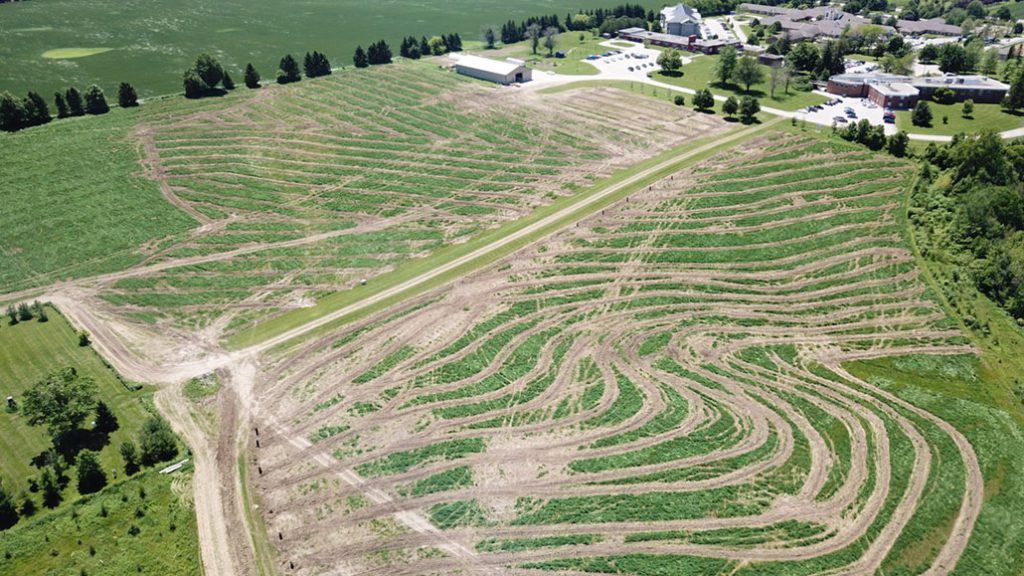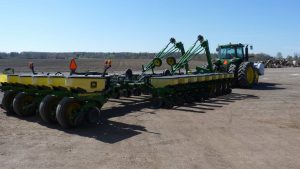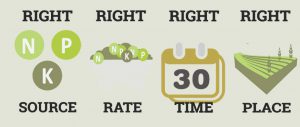Controlling runoff
TAKING TILE DRAINAGE TO THE NEXT LEVEL

| WHAT YOU NEED TO KNOW • Several agricultural organizations have formed the AGgrowth Coalition to advocate for an effective national BRM suite of programs. • The coalition includes Grain Farmers of Ontario, the Canadian Federation of Agriculture, Canadian Canola Growers Association, Grain Growers of Canada, the National Sheep Network, and the Canadian Horticultural Council. • The coalition has stated that AgriStability provides no coverage to most farmers facing risks outside of their control and has asked for increased support in the face of mounting farm losses resulting from poor harvests due to weather and global trade issues. • The federal response to AGgrowth’s request has been underwhelming, with no commitment for improved programs. |
CONTROLLING RUNOFF HAS become a major imperative for agriculture. Left unfettered, drainage can charge straight into a water system, taking sediment with it that could harm aquatic life and the environment. And these days, society is becoming increasingly intolerant of anything less than stellar management practices.
Runoff management is particularly challenging on contoured land; although water naturally drains coming off a contour, it can cause erosion.
Now, a unique initiative underway in Huron County, at the Huronview Farm near Clinton, is aiming to see if landowners can slow water down coming off contours as well as save it for subsurface irrigation, by managing it through a series of drainage control gates.
Doug Walker, a grain farmer and past president of the Huron Soil and Crop Improvement Association (HSCIA), is a key figure in the Huronview Contoured Drainage Demonstration Project.
“We want to illustrate that controlled contoured drainage can work, and that agriculture can work in harmony with society,” he says. “Everyone wants clean water, throughout the whole Great Lakes system.”
Huronview Farm has roots in the county going back to the 1800s. Then, it was a home for disadvantaged people who farmed to grow their own food. Over the years, it became the site of the Huronview home for seniors and the Huron County Health Unit. The county has traditionally rented the remaining land to farmers.
Runoff from the gently rolling farm ultimately drains into the Bayfield River. This region is a tourism magnet, and the water system itself is considered one of southern Ontario’s finest steelhead trout fly fishing streams. The river is coveted for being clear and clean — qualities not always seen in water courses that flow through important agricultural regions.
That’s where the Huronview Farm drainage project comes in.
LONG TERM PROJECT
HSCIA has a 15-year agreement to rent 47 acres of the 100-acre Huronview Farm. The drainage project involves all of the rented land on the Huronview Farm, along with about 15 acres from two adjacent farms, an eight-acre wetland, and a flood plain.
The project has two elements. The first involves drainage tile laterals laid on contour across the slope with a 0.1 per cent grade and control gates at the main (24 gates in total).
“The aim is to hold water back in the tile as needed, to reduce nutrient loss and downstream flows, potentially contributing to subsurface irrigation,” says Walker.
As well, three low-profile contoured terraces have been built on a smaller sub-basin of the field to intercept and redirect water to a grassed waterway then down to a wetland where sediment will settle out. The terraces are broad-based to allow for regular cropping. Walker says these terraces can cut water drainage speed by 75 per cent.
“They’re designed to move water sideways, slowing it down,” he says. “That gives time for sediment in the water to fall out.”
The contoured and controlled drainage system will be compared with a conventional pattern-tiled field, and a third field area which will remain untiled.
Monitoring of surface and subsurface water will be done by Ausable Bayfield Conservation Authority (ABCA).
SETTING AN EXAMPLE
The project has garnered a great deal of attention. Last June, about 350 people came to a demonstration day at the farm to learn more. That included representatives from the project sponsors: the Huron County Clean Water Project, the Land Improvement Contractors of Ontario, Ontario Ministry of Agriculture, Food and Rural Affairs, Grain Farmers of Ontario, Ducks Unlimited Canada, ABCA, and the Canadian Agricultural Partnership.
Attendees at the demonstration day saw the contoured drainage site being prepared, as well as other HSCIA initiatives, all focused on sustainability. At the Huronview Farm site, the association uses no-till practices and cover crops to minimize runoff and keep soil in place. The group has been documenting its farm practices, using Field to Market Canada (formerly known as the Canadian Field Print Initiative) to determine environmental impact. It consistently exceeds standards in many areas, including soil erosion risk, which is about half of the average Ontario farm.
SUSTAINABILITY
The association knows sustainability must be part of a bigger equation that includes profitability. So as part of the drainage project, its members will be monitoring yields to determine how the various water management approaches that are part of the project affect it.
Says certified crop advisor Wayne Wheeler, a director on HSCIA, “The three Ps of sustainability are people, planet, and your pocketbook. We can look after the environment and soil erosion, but if we go broke in the process, that’s not sustainable either, so we have to look at the economics as well.”
Adds Mike Buttenham, Grain Farmers of Ontario’s environment and sustainability coordinator, “Companies want farmers to verify their practices in the form of a sustainability scheme, to ensure the product they produce is sourced economically, that it’s environmentally and socially sustainable, and that there is no risk to them,” he says. “It’s something we see coming and we want to be present and make sure our farmer-members have the tools and the resources to meet these demands and provide value to their own operations.”
This project was funded by the Canadian Agricultural Partnership and run through ABCA.
DRAINAGE NOTES
Land Improvement Contractors of Ontario (LICO)
The Land Improvement Contractors of Ontario (LICO) is an association of professional contractors, suppliers of drainage pipe and equipment, engineers, and municipal drainage superintendents principally concerned with agriculture and the land drainage industry in Ontario. LICO Contractors are government licensed and principally design and lay tile drains on farms and construct the necessary municipal outlet drains. They also install pipe to drain the base of roads, lanes, and industrial subdivisions. LICO contractors build erosion control structures, lay water and sewage lines, and install sub irrigation and watertable control projects.
The Drainage Act
The Drainage Act was passed in 1990 to provide property owners with a process to solve drainage problems. The Ontario Ministry of Agriculture, Food and Rural Affairs (OMAFRA) has produced a Drainage Act Discussion paper. OMAFRA is proposing changes to the Drainage Act that would reduce burden, streamline approvals, and address stakeholder concerns while maintaining environmental standards. This includes creating a new streamlined Drainage Act process for minor improvements to drainage systems; enabling a simplified process to update the engineer’s report to account for changes to the design made during construction; and providing the minister with legislative authority to adopt technical protocols such as the DART Protocol by reference in regulation.
For more information:
www.drainage.org/
https://ero.ontario.ca/notice/019-1187
https://conservationontario.ca











